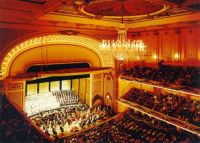
The Tragedy of Music Hall
Re-posted from Feb. 23, 2009 (Commentary).
Has the cockroach that ate Cincinnati struck again? http://www.youtube.com/watch?v=viTUhOT4d3I
On January 7, 2010, CSO music director Paavo Järvi announced that he will leave the orchestra at the end of the 2010-2011 season. Did 132-year-old Music Hall, built for huge choral festivals like Cincinnati's May Festival, have anything to do with it? Would Dr. Demento (video clip above) have had something to say?

Cincinnati Music Hall
|
Having once had a season ticket in the gallery, topmost level of the huge hall, which seats 3,516 according to the official Cincinnati Arts Association web site, though with wheelchair ramps and other flexible arrangements usually seats about 100 less, I decided to try again. Seats with a full view of the stage are also less expensive in the gallery than in other parts of the hall.
It is beautiful in the gallery, with a breathtaking view of the great crystal chandelier, the painting of the Muses on the ceiling, the great, gilded proscenium arch and red velvet seats below.

View of Music Hall auditorium from the gallery
|
The program itself invited an acoustical test, with a 30-piece orchestra performing selections from Handel’s “Water Music” and Ralph Vaughan Williams’ vast “A Sea Symphony,” with the 130-plus May Festival Chorus and an orchestra of 90. Attendance was perhaps 1,000, with people scattered all over the hall.
To begin with – and this is a given for most CSO concerts at Music Hall -- the performance was exemplary (review pending). The acoustics from the center of the gallery were extremely rewarding. You could hear reverbs from the walls -- enough to give the music a warm halo without excess. This was true of both the large and small ensembles, and diction by the chorus and guest artists Kelley Nassief, soprano, and baritone Brett Polegato was remarkably clear and intelligible, despite the poetic imagery of Vaughan Williams’ text (by Walt Whitman).
From an audience standpoint (though it varies in different parts of the hall) acoustics in Music Hall is not a problem. The CSO players have concerns of their own, i.e. hearing each other to maximize ensemble precision. This was addressed with more or less success in the late 1990s by moving the stage slightly forward, installing reflective surfaces above the orchestra and acoustical towers in the back.
Simply put, Music Hall is a big hall with fine acoustics. Telarc loves to record there and, in fact, the company just won a Grammy for best surround sound album for the CSO’s 2008 Mussorgsky release. (Unfortunately, CSO recording activities are now on indefinite hold for budgetary reasons.)
It’s the “big” that is the tragedy for Music Hall. It is by far the largest concert hall in the United States -- or anywhere else for that matter, even Beijing, China. Though CSO concerts would routinely fill and often sell out halls in much larger cities (Boston, Chicago, Los Angeles, Atlanta, for example) the perception from looking at the empty seats in Music Hall is that CSO concerts do not sell. That is false and a tragedy.
Compounding the problem for the CSO is the all-too-true notion that one need not subscribe, or even buy a ticket in advance, to get a good seat.
A live concert is a visual as well as an aural experience. Anyone who has attended a concert at Walt Disney Hall in Los Angeles or any of the newer concert halls in Europe, where audiences are drawn into the music simply by being closer to the musicians -- partially surrounding them in some cases -- has had their eyes and ears opened. The view of the CSO from the Music Hall gallery, while lovely, is kind of like big screen TV without the close-ups. It is certainly not intimate, and inter-action among the players and conductor, a vital aspect of CSO music director Paavo Järvi's great success with the orchestra, is virtually imperceptible without binoculars. It isn’t much better from most other points in the hall, either.
Another problem involves the “sanctity” of Music Hall. Audience abandonment of Cincinnati Ballet’s “Nutcracker” since it re-located to the Aronoff Center in 2007 underlines that. Do people come to see “Nutcracker” or Music Hall? Music Hall is beautiful without doubt, and one can gaze to distraction at the chandelier (the view is particularly spectacular in the gallery). But was Music Hall made for the CSO or the CSO for Music Hall (the answer is “no” to both questions)?
Talk of making structural changes to Music Hall – “downsizing” it, building a smaller auditorium adjacent to it – has been met with horror by some people in the community who cannot bear to see this icon touched in any way (unaware, perhaps, that it has undergone many changes in its 131-year history).
That Music Hall was unsuitable for CSO concerts was known from the beginning (the orchestra was founded in 1895). Music Hall was built in 1878 to house song festivals involving hundreds of singers (today’s descendant is the May Festival). Emery Auditorium (2,200 seats), now languishing empty and in disrepair on Walnut Street, was built for the CSO in 1911 when Leopold Stokowski was music director. The orchestra performed there happily for 25 years, until Music Hall needed an anchor tenant for fear it might be destroyed.
The ultimate tragedy of Music Hall – and by extension the CSO -- is that the economy may have the final say. Until the current recession took hold (and signs are that it will only deepen), there was optimism that something would be done to give the symphony the venue it deserves and still honor Music Hall. That, too, is on hold waiting further developments.
The one bright spot in this dismal picture is that CSO attendance has actually increased this season, by 14 per cent. Counter-intuitive though this may be and how long it will last remain to be seen (the CSO’s 2009-10 season will be announced March 8).